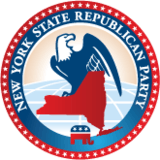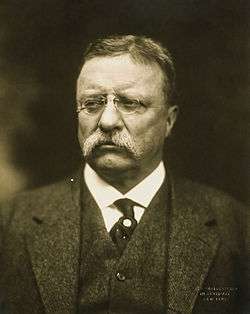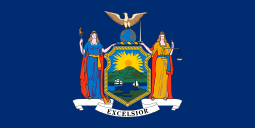New York Republican State Committee
New York State Republican Committee | |
|---|---|
 | |
| Chairperson | Edward F. Cox |
| Assembly leader | Brian Kolb |
| Senate leader | John J. Flanagan |
| Founded | 1855 |
| Headquarters |
315 State Street Albany, NY 12210 |
| Ideology |
Liberal conservatism Economic liberalism Fiscal conservatism |
| National affiliation | Republican Party |
| Colors | Red |
| New York State Assembly |
44 / 150 |
| New York State Senate |
31 / 63 |
| New York City Council |
3 / 51 |
| U.S. House of Representatives (New York) |
9 / 27 |
| U.S. Senate (New York) |
0 / 2 |
| Website | |
|
www | |
The New York Republican State Committee established 1855, is an affiliate of the United States Republican Party (GOP). Its headquarters are in Albany, New York.[1]
The purpose of the committee is to nominate Republican candidates for election to New York state and federal political roles.[2] It also formulates Republican Party policy on New York State issues and assists its nominees in their election campaigns.
History

The New York Republican State Committee was established in 1855, one year after the founding of the "Republican Party" by William H. Seward and Thurlow Weed.[2] Initially, the committee met every three years to plan the Republican National Convention and it occasionally met during the election campaigning periods.
The establishment of the Republican Party in New York in the 1850s was a difficult task. At the time, the nativist American Party, (a party evolved from the Know Nothing Party) was active. However, the committee presented nominees from a party with well-recognized members, a defined set of principles, stable, powerful, well-known leaders and a well established structure. The committees nominees were first successful in 1856.[3] Around 1894, when immigration was at its peak, the New York State Constitution created a clause which caused upstate New York to have reappointed districts so that there would be more votes per district. This gave native New Yorkers more votes than immigrants. It was not until 1974 that the US Supreme Court deemed this clause unconstitutional. This created a turmoil in the politics of New York because the Republican party lost its hold on the state legislature.[2]
Until 1911, the New York Republican State Committee nominated its candidates through a primary or caucus system. This system meant the average voter had very little input as to who would be their choice for the state and federal offices. This system was taken out of practice after the passing of the Direct Primary Law in 1911, which allowed for more input from those present at the primary.[2]
Policy
Small business and agriculture

The committee, like its national body, promotes agriculture as an industry to strengthen the state economy via its "flow on" effect. It cites the benefits to employment, small business and the food industry as well as development of arable land for marketing.[4]
Ethics
Senator Andrew Lanza, the chairman of the Ethics Committee, sponsored the Public Integrity Reform Act of 2011 which was signed into law in the week of August 14, 2011. The Act focuses on financial disclosure of businesses and lobbyists and penalties for non-compliance.[5]
Energy
The committee promotes PACE financing for the purchase of clean energy infrastructure by New York citizens. Up front costs may be diffused over many years.[6]
Electricity
The committee supports the construction of a smart grid in New York to provide cost and efficiency benefits in the supply of power.[6]

Natural gas
The New York Republican State Committee encourages the use of marcellus shale in southern New York for extraction of natural gas. In 2008, Governor David Paterson approved the extension of the drilling area and protections for property owners.[7]
Taxes
The committee agreed with the passing of the bipartisan "Job Creation and Retention Package" on 19 January 2011, where concessions were given to small business employers.[8][9] The committee proposed a cap on school property tax excluding new properties.[10]
Health care
The New York Republican State Committee opposes all government-run healthcare. Instead, it supports competition between health care providers in the private sector.[11] The committee also suggests specialised medical malpractice courts or "health courts".[12]
Organization
| Office | Office-holder |
|---|---|
| Chairman | Edward F. Cox |
| First Vice Chairman | Bill Reilich |
| Secretary | Rebecca Marino |
| Treasurer | John Riedman |
| Chief of Staff | Tony Casale |
| National Committeewoman | Jennifer Saul |
| National Committeeman | Lawrence Kadish |
County committee
New York State has 62 counties. Every two years, in each county, Republicans elect a "Republican County Committee". The chair of each county committee is the face of the Republican Party in that county. New York also has 150 Assembly districts. Republicans elect one male and one female leader in each district. The district leaders form the executive committee of the respective county committee. The chair and the executive committee seek new party members; control local finances; find candidates to run for public office and choose the nominee (unless both candidates have petitioned enough signatures to trigger a primary).[2]
State committee
The New York State Republican State Committee is composed of one male and one female representative from each Assembly District. Before each statewide election, the committee organises a party convention and chooses candidates for offices of the state. 60% of the committee's vote is needed to win the party's nomination. If no candidate wins 60% of the committee's vote, the candidates with more than 25 percent of the committee's vote compete in a "primary" which is held in the month of September. A candidate with less than 25 percent of the committee's vote may compete in the "primary" if they have a petition of support of greater than 15000 voters.
The State Committee also elects one National Committeewoman and one National Committeeman to represent the state committee to the Republican National Committee in Washington, D.C. The current National Committee members are Jennifer Saul, a Republican fundraiser and former chairwoman of the New York County Republican Committee, and Lawrence Kadish, a real estate developer from downstate New York.
Current elected officials
The New York Republican Party holds a majority in the New York State Senate and 9 of the state's 27 U.S. House seats.
Members of Congress
U.S. House of Representatives
- Lee Zeldin, 1st District
- Peter T. King, 2nd District
- Chris Gibson, 19th District
- Daniel M. Donovan, 11th District
- Elise Stefanik, 21st District
- Richard L. Hanna, 22nd District
- Tom Reed, 23rd District
- John Katko, 24th District
- Chris Collins, 27th District
Statewide offices
- None
Notable Legislators
- Co-President Pro Tem of the Senate/Senate Republican Leader: John J. Flanagan
- Assembly Minority Leader: Brian Kolb
- New York City Council Minority Whip: Joseph Borelli
| Chair | Tenure | Hometown while serving |
|---|---|---|
| Edwin D. Morgan | 1856–1858 1874–1875 | Manhattan |
| James Kelly | 1858–1860 | Manhattan |
| Simeon Draper | 1860–1862 | Manhattan |
| Henry R. Low | 1862–1863 | Monticello |
| Charles Jones | 1863–1865 | Brooklyn |
| William R. Stewart | 1865–1866 | Manhattan |
| Hamilton Harris | 1866–1870 | Albany |
| Alonzo B. Cornell | 1870–1874 1875–1877 1878–1879 | Manhattan |
| John F. Smyth | 1877–1878 1882–1883 | Albany |
| Chester A. Arthur | 1879–1881 | Manhattan |
| B. Platt Carpenter | 1881–1882 | Stanford |
| James D. Warren | 1883–1885 | Buffalo |
| Chester S. Cole | 1885–1887 | Corning |
| Cornelius N. Bliss | 1887–1889 | Manhattan |
| John N. Knapp | 1889–1891 | Auburn |
| William H. Brookfield | September 1891 – September 1894 | |
| Charles W. Hackett | September 1894 – April 1898 | Utica |
| Benjamin B. Odell Jr. | May 1898 – November 1900 April 1904 – September 1906 | Newburgh |
| George W. Dunn | November 1900 – April 1904 | Binghamton |
| Timothy L. Woodruff | September 1906 – October 1910 | Brooklyn |
| Ezra P. Prentice | October 1910 – January 1911 | Manhattan |
| William Barnes Jr. | January 1911 – September 1914 | Albany |
| Frederick C. Tanner | October 1914 – January 1917 | Manhattan |
| George A. Glynn | January 1917 – September 1922 | Watertown |
| George K. Morris | September 1922 – August 1928 | Amsterdam |
| H. Edmund Machold | August 1928 – June 1929 | Watertown |
| William J. Maier | June 1929 – November 1930 | Seneca Falls |
| W. Kingsland Macy | December 1930 – September 1934 | Islip |
| Melvin C. Eaton | September 1934 – November 1936 | Norwich |
| William S. Murray | January 1937 – April 1940 | Utica |
| Edwin F. Jaeckle | April 1940 – November 1944 | Buffalo |
| Glen R. Bedenkapp | January 1945 – February 1949 | Lewiston |
| William L. Pfeiffer | 1949 – September 1953 | Buffalo |
| Dean P. Taylor | September 1953 – September 1954 | Troy |
| L. Judson Morhouse | September 1954 – January 1963 | Ticonderoga |
| Fred A. Young | April 1963 – January 1965 | Lowville |
| Carl Spad | February 1965 – May 1967 | White Plains |
| Charles A. Schoeneck, Jr. | May 1967 – April 1969 | Syracuse |
| Charles T. Lanigan | 1969 – November 1972 | Utica |
| Richard M. Rosenbaum | November 1972 – June 1977 | Rochester |
| Bernard M. Kilbourn | June 1977 – 1981 | Utica |
| George L. Clark Jr. | March 1981 – July 1985 | Brooklyn |
| Anthony J. Colavita | September 19, 1985 – June 22, 1989 | Westchester County |
| J. Patrick Barrett | June 22, 1989 – January 14, 1991 | Syracuse |
| William D. Powers | January 14, 1991 – March 8, 2001 | Rensselaer County |
| Alexander F. Treadwell | March 8, 2001 – November 15, 2004 | Westport |
| Stephen J. Minarik | November 15, 2004 – November 15, 2006 | Webster |
| Joseph N. Mondello | November 15, 2006 – September 29, 2009 | Hempstead |
| Edward F. Cox | September 29, 2009 – present | Manhattan |
See also
References
- 1 2 Archived May 14, 2010, at the Wayback Machine.
- 1 2 3 4 5 "New York Republican State Committee". Library.albany.edu. Retrieved 2016-01-07.
- ↑ Silbey, Joel (1985). The Partisan Imperative New York: Oxford University Press
- ↑ Patty Ritchie (2011-12-02). "Sen. Ritchie Asks the Experts: How Do We Make Farming Grow? | NY State Senate". Nysenate.gov. Retrieved 2016-01-07.
- ↑ Andrew J Lanza. "Senator Andrew Lanza, Chairman of the Senate Ethics Committee & Co-Chair of the Legislative Ethics Commission, Announces New Ethics Reform Law | NY State Senate". Nysenate.gov. Retrieved 2016-01-07.
- 1 2 "Power NY: The New NY Agenda" (PDF). Andrew Cuomo 2010. Archived from the original (PDF) on October 8, 2010. Retrieved December 8, 2011.
- ↑ Archived October 14, 2011, at the Wayback Machine.
- ↑ Archived November 2, 2011, at the Wayback Machine.
- ↑ James S. Alesi. "Senator Alesi Job Creation Legislation Passes Senate WITH Bipartisan Support / the Job Creation and Retention Package Is the First Bill Passed by the Senate in 2011 | NY State Senate". Nysenate.gov. Retrieved 2016-01-07.
- ↑ Archived April 25, 2012, at the Wayback Machine.
- ↑ Archived November 25, 2011, at the Wayback Machine.
- ↑ "Health Care Courts for New York". Archived from the original on October 13, 2011. Retrieved November 2, 2011.
External links
- New York Republican State Committee
- New York State Senate Republican Campaign Committee
- New York State Young Republicans
- New York State Federation of Republican Women
- New York Young Republican Club
